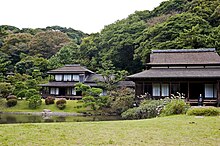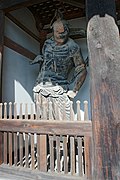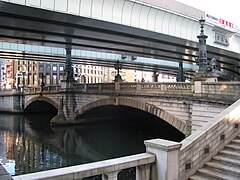Important cultural asset of Japan
Important cultural property of Japan ( Japanese 重要 文化 財 , Jūyō Bunkazai or Jūbun 重 文 for short ) is an official classification of cultural goods, which is made by the Office for Cultural Affairs . In Japan, a distinction is made between “ material ” ( 有形 文化 財 , Yūkei bunkazai , English Tangible Cultural Properties) and “ intangible cultural properties ” ( 無形 文化 財 , Mukei bunkazai , English Intangible Cultural Properties). The appointment is made when a material cultural asset has "important and special significance". The cultural property must meet a catalog of criteria for appointment and go through a legally regulated appointment process. Important cultural assets can also be elevated to a national treasure and thus further emphasized in their importance.
classification
In order to protect Japan's cultural heritage, the Cultural Property Protection Act ( 文化 財 保護 法 , Bunkazai hogohō , English Law for the Protection of Cultural Properties) was enacted in May 1950 . The law created a “procedure for the appointment” ( 指定 制度 , Shiteiseido ) of cultural goods, which also set restrictions on the modification, repair and export of cultural goods.
In addition to the appointment process, there is also a "registration process" ( 登録 制度 , Tōrokuseido ) that guarantees a low level of protection and care. This means that a cultural property first goes through the registration and then the appointment process in order to obtain the status of an official cultural property. A distinction is made between material and immaterial cultural assets. The material cultural assets such as buildings , paintings, sculptures , old books, historical documents and archaeological finds can still be designated as "important cultural assets". As important cultural assets, they are divided into three classes: city-wide ( 市 定 重要 文化 財 , Shijō Jūyō Bunkazai ), prefecture-wide ( 県 定 重要 文化 財 , Kenjō ~ ) or nationwide ( 国 定 重要 文化 財 , Kokujō ~ ) important cultural assets. The assignment to the classes is cumulative, not exclusive. For example, the Japanese garden “ Sankei-en ” in Yokohama is classified as an important cultural asset throughout the city and country. Finally, important cultural assets can also be elevated to national treasures .
Hints
- In the case of temples, castles, etc., each individual building is classified separately, never the ensemble as a whole.
- There are around 100 Chinese picture scrolls from the Song / Yüan period that are classified as "important". There are also some national treasures among them .
Some important cultural assets
Temple Seiganto-ji in Wakayama Prefecture
Nihonbashi in Tokyo
Tsūjun Bridge, Kumamoto Prefecture
Shrine tsurugaoka hachimangū in Kamakura in Kanagawa Prefecture
Web links
Remarks
- ↑ Literally translated, these are cultural assets "without form"
-
↑
See Section 27 (Part III) of the Japanese Cultural Property Protection Act :
- Paragraph 1: The Minister of Education and Cultural Affairs can designate material cultural goods as “important cultural goods”. Marked with (a) in directories and catalogs.
- Paragraph 2: The minister of culture can designate a selection as a national treasure from among the important cultural assets, taking into account the world's cultural assets. Marked with (b) in directories and catalogs.
- ↑ When cultural property is spoken of in the following, then officially already officially appointed cultural property is meant. Objects that have not been officially declared a cultural asset are commonly referred to here as cultural property.
Individual evidence
- ^ A b Cultural Properties for Future Generations. (No longer available online.) In: Administration of Cultural Affairs in Japan - Fiscal 2009. Bunka-chō , June 2007, archived from the original on March 27, 2009 ; accessed on January 20, 2012 (English). Info: The archive link was inserted automatically and has not yet been checked. Please check the original and archive link according to the instructions and then remove this notice.
- ↑ the Sankei Garden in Yokohama (Japanese)








